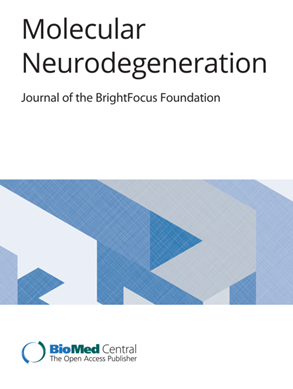转录因子组合MEF2和KLF7促进损伤脊髓轴突发芽,功能改善和再生相关基因表达
IF 17.5
1区 医学
Q1 NEUROSCIENCES
引用次数: 0
摘要
中枢神经系统(CNS)损伤后的轴突再生不仅受到抑制环境的限制,而且还因为损伤的神经元不能启动再生相关基因(RAGs)的表达。强RAG表达促进中枢神经系统再生的潜力通过条件反射损伤模型得到证实,即周围神经损伤促进损伤神经元中央突出分支的再生。通过传递正确的转录因子(TFs),可以潜在地诱导RAG的表达。我们在这里的目标是确定激活该程序的TF组合。我们首先分析了RAG程序启动子中的结合位点基序,以确定9个候选的促生长tf。这些都是体外系统筛选,以确定具有有效的神经突生长促进活性的组合。接下来,使用腺相关病毒载体在L4/L5背根神经节体内表达这些TF组合,以测试它们是否会促进雌性大鼠脊髓损伤模型(背柱病变)的再生。为了确定它们是否可以激活RAG程序,我们对激光解剖的特异性表达这些TF组合的背根神经节神经元和被axocut的DRG神经元进行了基因表达谱分析。启动子分析发现ATF3、Jun、CEBPD、KLF7、MEF2、SMAD1、SOX11、STAT3和SRF是候选的rag激活tf。体外筛选鉴定出两种TF组合,KLF7/MEF2和ATF3/KLF7/MEF2,具有有效的神经突生长促进活性,后者更强。在体内,KLF7/MEF2而不是ATF3/KLF7/MEF2或KLF7或MEF2单独促进轴突发芽进入背柱病变部位并改善功能恢复。基因表达谱出人意料地显示,MEF2- vp16构建体在体内几乎没有转录活性,这表明可能需要额外的步骤来实现完全的MEF2活性。除MEF2单独组合外,所有组合均显著诱导了切轴诱导的RAG表达镜像,而ATF3/KLF7/MEF2、KLF7和ATF3也诱导了可能阻碍再生的凋亡相关基因,但KLF7/MEF2不诱导。TF组合KLF7/MEF2部分模拟调节损伤效应,诱导轴突萌发成背柱损伤,驱动RAG显著表达,也促进功能改善。本文章由计算机程序翻译,如有差异,请以英文原文为准。
The transcription factor combination MEF2 and KLF7 promotes axonal sprouting in the injured spinal cord with functional improvement and regeneration-associated gene expression
Axon regeneration after injury to the central nervous system (CNS) is limited by an inhibitory environment but also because injured neurons fail to initiate expression of regeneration associated genes (RAGs). The potential of strong RAG expression to promote regeneration in the CNS is exemplified by the conditioning lesion model, whereby peripheral nerve injury promotes regeneration of centrally projecting branches of the injured neurons. RAG expression could potentially be induced by delivery of the right set of transcription factors (TFs). We here aim to identify TF combinations that activate this program. We first analysed binding site motifs in promoters of the RAG program to identify nine candidate growth-promoting TFs. These were systematically screened in vitro to identify combinations that had potent neurite-growth promoting activity. Next, adeno-associated viral vectors were used to express these TF combinations in vivo in L4/L5 dorsal root ganglia to test whether they would promote regeneration in a spinal cord injury model (dorsal column lesion) in female rats. To determine whether they could activate the RAG program we carried out gene expression profiling on laser-dissected dorsal root ganglion neurons specifically expressing these TF combinations, and of DRG neurons that had been axotomized. Promoter analysis identified ATF3, Jun, CEBPD, KLF7, MEF2, SMAD1, SOX11, STAT3 and SRF as candidate RAG-activating TFs. In vitro screening identified two TF combinations, KLF7/MEF2 and ATF3/KLF7/MEF2, that had potent neurite-growth promoting activity, the latter being the more powerful. In vivo, KLF7/MEF2, but not ATF3/KLF7/MEF2 or KLF7 or MEF2 alone, promoted axonal sprouting into the dorsal column lesion site and led to improved functional recovery. Gene expression profiling revealed that unexpectedly, the MEF2-VP16 construct used had little transcriptional activity in vivo, suggesting additional steps may be required to achieve full MEF2 activity. All combinations except MEF2 alone induced RAG expression mirroring that induced by axotomy to significant extents, while ATF3/KLF7/MEF2, KLF7 and ATF3, but not KLF7/MEF2 also induced apoptosis-related genes which may hinder regeneration. The TF combination KLF7/MEF2 partially mimics the conditioning lesion effect, inducing axonal sprouting into a dorsal column lesion and driving significant RAG expression, and also promotes functional improvement.
求助全文
通过发布文献求助,成功后即可免费获取论文全文。
去求助
来源期刊

Molecular Neurodegeneration
医学-神经科学
CiteScore
23.00
自引率
4.60%
发文量
78
审稿时长
6-12 weeks
期刊介绍:
Molecular Neurodegeneration, an open-access, peer-reviewed journal, comprehensively covers neurodegeneration research at the molecular and cellular levels.
Neurodegenerative diseases, such as Alzheimer's, Parkinson's, Huntington's, and prion diseases, fall under its purview. These disorders, often linked to advanced aging and characterized by varying degrees of dementia, pose a significant public health concern with the growing aging population. Recent strides in understanding the molecular and cellular mechanisms of these neurodegenerative disorders offer valuable insights into their pathogenesis.
 求助内容:
求助内容: 应助结果提醒方式:
应助结果提醒方式:


